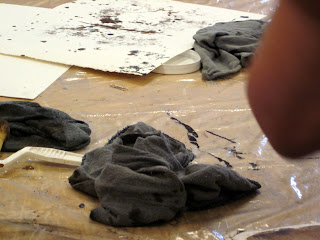The main event of last school year at The Press was our full class, Book & Book Structure, which was taught by Visiting Professor Robin Price. We bring in a different visiting faculty person every year, and thus the special focus of the class changes slightly every time. The special focus of last year’s class was Robin’s specialty: “chance operations.”
The class is officially an Art Studio, but in true Liberal Arts style, it includes many disciplines that intersect in the making of books: creative writing, literature, history, science, etc.
The class ran during Block 7. A great deal of ground was covered, much more than we actually have documentation of at this point. But we will do what we can. Better to begin at the beginning.
The class began with a get-in-there & get-your-hands-dirty & let-go & see-what-this-stuff-does & see-how-these-things-work exercise. Which is often the best way to start a class: by immediately throwing open the door to exploration.
To begin, each student was given a largish piece of Rives BFK, some india ink, and a variety of implements (brushes, sticks, silverware, etc.). They were told to make marks on the sheet with the ink, either with their eyes closed and/or with their non-dominant hands. After this initial marking (which broke the inevitable hesitancy before the purity of a clean sheet of paper) the students spent some time exploring markmaking with other tools and refining what they had done. After a certain amount of time, they had to stop and pass their sheet to the person next to them.
When they got their new sheet, the students were instructed to tear it in half, and then fold each piece in half to form two folios of an eight page book. Then they were given another medium, a warm, brown ink—“walnut stain” used for calligraphy. During this second phase they were supposed to begin ordering the book in response to the marks already present on the paper (not made by them) and the shape & order of the pages. They did this for a set amount of time and then passed their sheets to the person next to them.
They tore and folded each sheet in half again, in order to make a four folio/16 page book. And then they had to finish their books by bringing some sequence, order, and unity to the initial chaos.








No comments:
Post a Comment